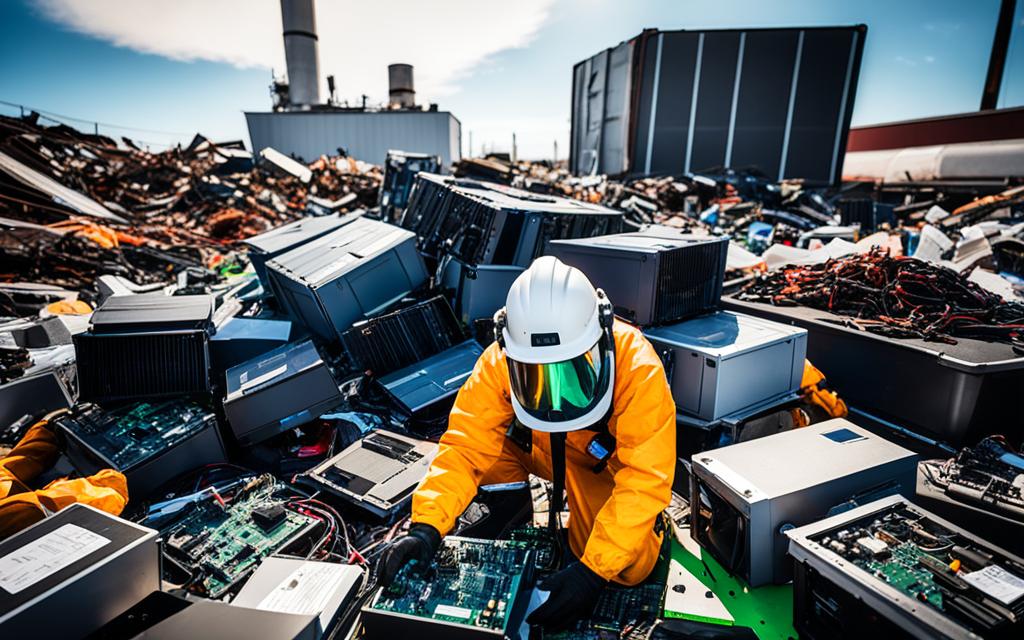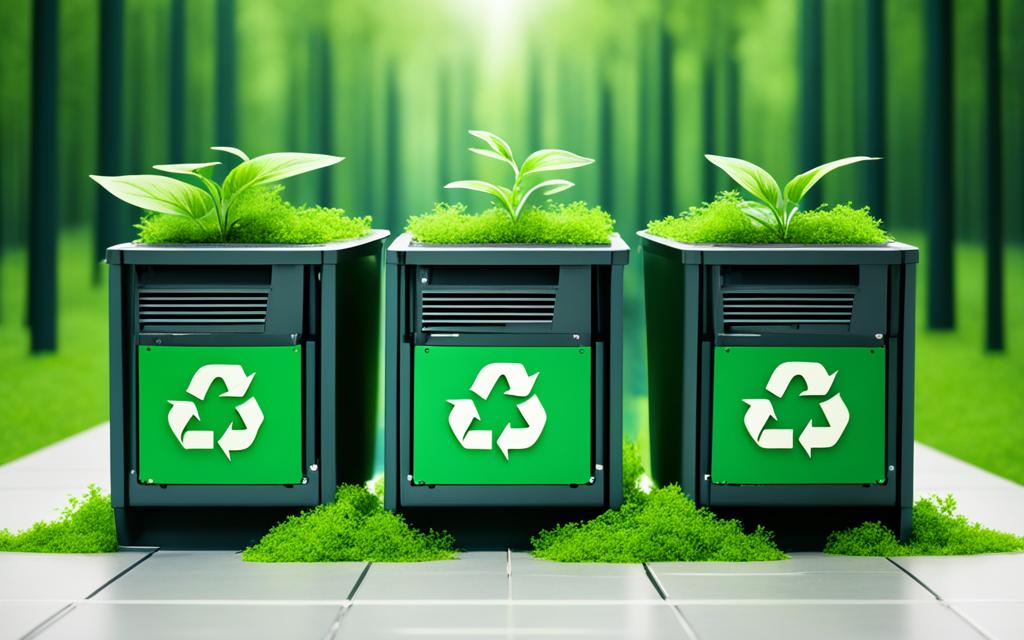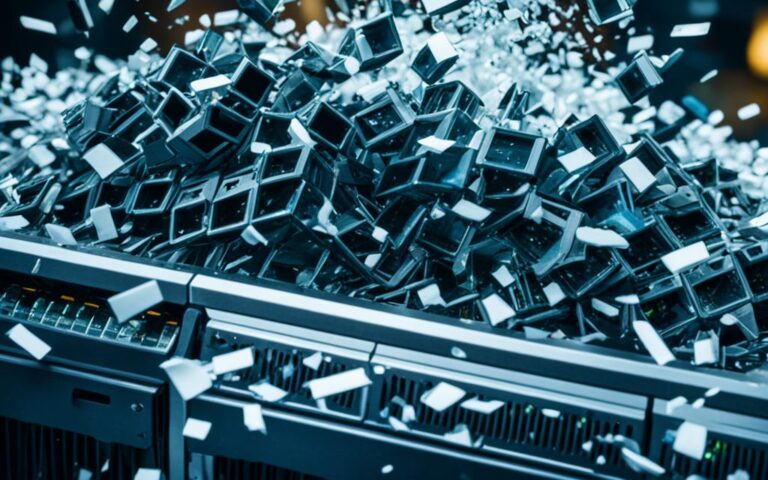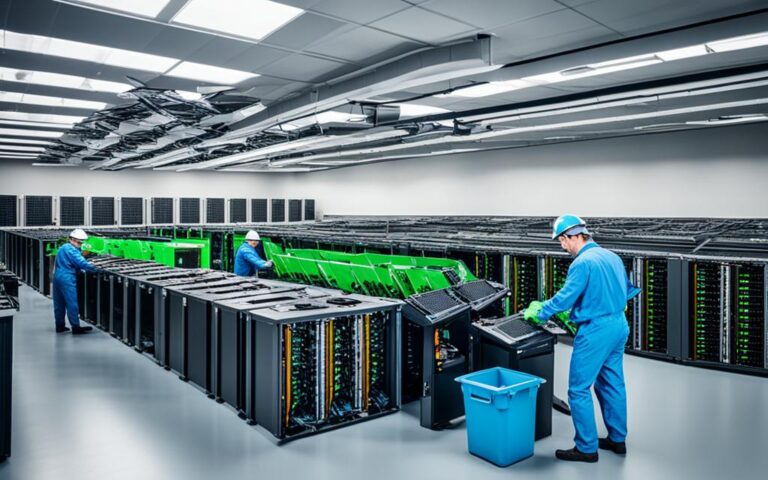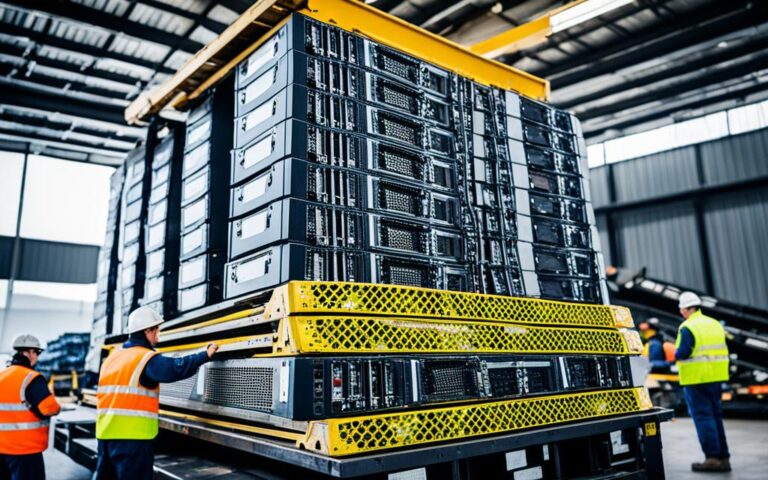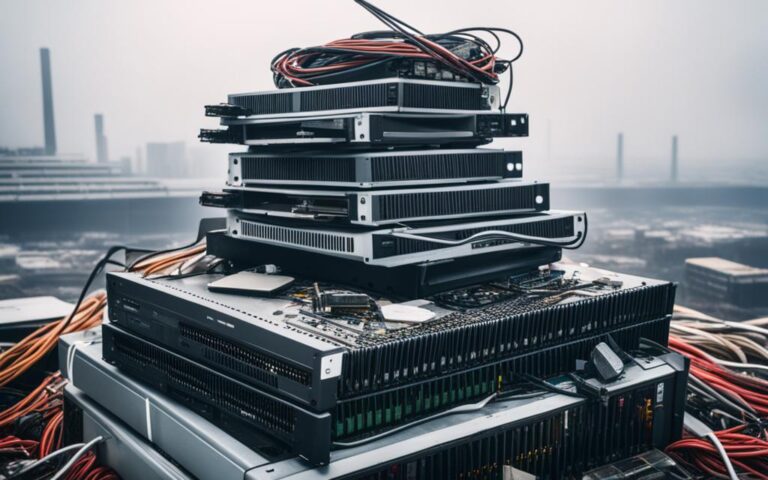The Role of Server Recycling in Reducing E-Waste
As our world becomes increasingly digital, the issue of electronic waste, or e-waste, has become a pressing concern. The improper disposal of electrical items contributes to pollution, environmental damage, and the depletion of valuable resources. In fact, it is projected that e-waste will nearly double by 2030, with less than 20% of discarded items being properly recycled.
One significant contributor to e-waste is the disposal of server equipment in data centres. The rapid pace of technological innovation often leads to the premature disposal of racks, circuits, and other components, resulting in a substantial accumulation of server e-waste.
However, there is hope for a more sustainable future. By implementing a strategic approach to hardware lifecycles and prioritizing server recycling, we can help mitigate the impact of e-waste and work towards a greener and more sustainable digital landscape.
Server recycling is a key part of the solution in reducing e-waste. By recycling outdated equipment, we can reclaim valuable materials and reduce the need for new resource extraction. This not only helps protect the environment but also promotes a circular economy, where resources are kept in use for as long as possible.
Together, by embracing server recycling and sustainable practices, we can pave the way for a more sustainable future. Let us join forces to reduce e-waste, conserve resources, and create a green digital ecosystem for generations to come.
The Current State of the E-waste Problem
In 2019, a staggering 53.6 million metric tons of e-waste were generated worldwide. Projections show a further 40% increase by 2030. Less than 20% of discarded electrical items are properly recycled, leading to pollution and environmental damage. This accumulation of e-waste poses significant challenges to sustainability standards and materials shortages. Urgent action is needed to address this crisis.
E-waste crisis is a pressing issue that demands immediate attention. The rapid growth in technology adoption has resulted in an alarming increase in electronic waste, putting pressure on our ecosystems and resources. The improper disposal of electronic devices, including smartphones, laptops, and other gadgets, contributes to the pollution of our air, land, and water.
“We are facing a global crisis when it comes to e-waste. The ever-increasing demand for new gadgets and the rapid obsolescence of older devices have created a perfect storm of electronic waste. It is imperative that we take urgent action to address this problem and implement sustainable practices to reduce, recycle, and repurpose electronic waste.”
Sustainability standards and the responsible management of e-waste are crucial for ensuring a more sustainable future. This includes adopting circular economy principles, promoting reuse and recycling, and reducing the consumption of raw materials. Additionally, it is essential to address the materials shortages caused by the growing demand for electronic devices.
By implementing sustainable strategies for e-waste management, we can mitigate the negative environmental impact and contribute to a more sustainable future. This requires collaboration between governments, businesses, and individuals to prioritize recycling initiatives, invest in innovative recycling technologies, and educate consumers about the importance of responsible e-waste disposal.
The Urgency of Taking Action
The urgency to address the e-waste crisis cannot be overstated. Failure to act now will have far-reaching consequences, jeopardizing the health of our planet and future generations. Immediate action is needed to combat the rising tide of e-waste and ensure a sustainable and resource-efficient world.
It’s time for governments, organizations, and individuals to come together and implement systemic changes to tackle the e-waste crisis. Only through collective effort and urgent action can we overcome the challenges posed by e-waste and move towards a more sustainable future.
Join the movement for responsible e-waste management and make a difference today!
E-waste Generated by Data Centers
Data centers play a significant role in contributing to e-waste through the disposal of racks, computing equipment, monitors, circuits, and other electrical components. The rapid pace of innovation often leads to premature disposal of perfectly functional equipment, resulting in the accumulation of server e-waste. To address this issue, data centers need to adopt a sustainable approach towards e-waste management.
By implementing proactive measures such as reducing, reusing, and recycling e-waste, data centers can minimize their environmental impact. One effective strategy is to extend the lifespan of equipment through regular maintenance and upgrades. By optimizing energy consumption, data centers can further reduce their carbon footprint and contribute to a more sustainable future.
E-waste generated by data centers contributes to the growing global e-waste crisis. It is essential for data centers to adopt a sustainable approach in order to minimize their impact on the environment.
The Importance of Sustainable Approaches
When it comes to e-waste generated by data centers, adopting sustainable practices is crucial. The disposal of electrical components, such as racks and computing equipment, contributes to the ever-increasing amount of server e-waste. By adopting a sustainable approach, data centers can significantly reduce their environmental impact.
There are several key benefits to adopting a sustainable approach towards e-waste generated by data centers:
- Environmental preservation: By reducing, reusing, and recycling e-waste, data centers can minimize resource depletion, pollution, and environmental damage.
- Financial savings: Implementing sustainable strategies can help data centers save money by reducing the need to constantly purchase new equipment and minimizing energy consumption.
- Compliance with regulations: Proper e-waste management ensures data centers comply with environmental regulations and avoid legal consequences.
By taking a sustainable approach towards e-waste management, data centers not only contribute to a cleaner environment but also set an example for other industries to follow.
| Sustainable Approach | Benefits |
|---|---|
| Reduce | – Minimizes resource depletion – Reduces energy consumption |
| Reuse | – Extends equipment lifespan – Saves money on purchasing new equipment |
| Recycle | – Prevents e-waste from ending up in landfills – Promotes the circular economy |
The Impact of Obsolete Equipment
Obsolete equipment plays a significant role in contributing to the growing issue of server e-waste in data centers. With the rapid pace of technological advancements, older equipment quickly becomes outdated and is replaced, resulting in a substantial amount of discarded hardware. This continuous cycle of obsolescence significantly contributes to the accumulation of server e-waste, posing environmental challenges and sustainability concerns.
Data centers must adopt a sustainable mindset to address the impact of obsolete equipment. Instead of prematurely disposing of hardware, they should focus on extending the lifespan of their equipment through maintenance, upgrades, and optimizing resource allocation. By implementing these sustainable practices, data centers can not only reduce the environmental impact of server e-waste but also contribute to the circular economy by repurposing or recycling components.
Extending Equipment Lifespan
One key approach to tackling the impact of obsolete equipment is to extend its lifespan. By maximizing the usefulness of existing hardware, data centers can minimize the need for frequent replacements and ultimately reduce the volume of e-waste generated. This involves implementing regular maintenance schedules, ensuring efficient cooling systems, and upgrading components to keep up with evolving technology. By adopting such practices, data centers can reduce both their environmental footprint and the financial burden of frequent hardware purchases.
The continuous cycle of obsolescence significantly contributes to the accumulation of server e-waste, posing environmental challenges and sustainability concerns.
Repurposing and Recycling Components
Another effective way to mitigate the impact of obsolete equipment is to repurpose or recycle components. Rather than disposing of entire systems, data centers should explore opportunities to reuse functional components in other areas of their infrastructure. This not only promotes resource efficiency but also reduces the demand for new hardware. Additionally, when components have reached the end of their useful life, responsible recycling practices ensure the recovery of valuable materials and minimize the environmental impact of their disposal.
Data centers need to prioritize sustainable practices that address the impact of obsolete equipment on server e-waste. By extending equipment lifespan and implementing measures to repurpose or recycle components, data centers can reduce their environmental impact, contribute to the circular economy, and pave the way towards a more sustainable future.
E-waste Management Strategies
E-waste management is crucial in reducing the environmental impact of data centers. By implementing sustainable strategies that focus on reducing, reusing, and recycling, data centers can effectively manage their e-waste and contribute to a greener future.
Minimize Equipment Purchases
One of the key strategies in e-waste management is to minimize the purchase of new equipment. By evaluating the actual need for new hardware and considering alternatives such as server virtualization or cloud computing, data centers can reduce the amount of e-waste generated. This not only helps to save resources and reduce environmental impact but also contributes to cost savings for the organization.
Extend Equipment Lifespan
Extending the lifespan of equipment through maintenance and repurposing is another effective strategy for e-waste management. By regularly maintaining and upgrading components, data centers can maximize the use of existing hardware, reducing the need for premature equipment replacements. Additionally, repurposing older equipment for secondary functions, such as testing or development environments, can further extend its useful lifespan.
Partner with Certified Recyclers
Partnering with certified recyclers is essential for proper disposal of e-waste. Data centers should collaborate with reputable recycling companies that follow environmentally responsible practices. Certified recyclers ensure that the e-waste is processed in compliance with regulations and that valuable materials are recovered for reuse. Working with these specialized partners not only ensures proper e-waste management but also promotes a circular economy where valuable resources are conserved.
“Effective e-waste management strategies prioritize reducing, reusing, and recycling. By adopting these practices, data centers can minimize their environmental impact and contribute to a sustainable future.”
Follow the Waste Hierarchy
To effectively manage e-waste, data centers should adhere to the waste hierarchy of reduce, reuse, and recycle. This approach prioritizes prevention and reduction of waste generation, followed by reusing materials or components, and finally recycling what cannot be reused. By following this hierarchy, data centers can make significant progress in managing their e-waste and minimizing environmental impact.
| Strategy | Description |
|---|---|
| Minimize Equipment Purchases | Reduce the purchase of new equipment by evaluating the need and exploring alternative solutions. |
| Extend Equipment Lifespan | Maintain and upgrade existing hardware to extend its useful life and avoid premature replacements. |
| Partner with Certified Recyclers | Collaborate with reputable recyclers to ensure proper disposal of e-waste and recovery of valuable materials. |
| Follow the Waste Hierarchy | Adhere to the waste hierarchy of reduce, reuse, and recycle to effectively manage e-waste. |
E-waste Management Solutions
In order to effectively manage server e-waste, data centers should prioritize sustainable solutions. Engaging reputable waste disposal companies with a zero waste to landfill policy ensures responsible handling of e-waste and compliance with environmental regulations. By choosing local service providers, data centers can minimize emissions and reduce the risks of improper disposal.
Data centers can also play a significant role in promoting a greener IT industry by prioritizing sustainable replacements for their equipment. By adopting energy-efficient technologies and practices, they contribute to reducing the overall environmental impact. These sustainable replacements not only help in the proper disposal of e-waste but also offer economic benefits in the long run.
By embracing server recycling, e-waste disposal, and sustainable replacements, data centers can make a substantial positive impact on the environment. This approach promotes the circular economy, reduces the accumulation of harmful waste, and contributes to a more sustainable future for the IT industry.
Channel Companies’ Response to E-waste Management
Channel companies are actively addressing the issue of server e-waste by incorporating sustainable practices into their operations. They understand the importance of reducing waste generation and minimizing carbon footprints in the IT industry. By prioritizing responsible server recycling, channel companies are not only making a positive impact on the environment but also demonstrating their commitment to environmental responsibility.
These companies understand that server e-waste is a pressing concern that requires immediate action. They are aware of the negative consequences of improper disposal and the need to move towards a greener future. By partnering with certified recyclers and adopting sustainable strategies, channel companies are taking significant steps towards reducing their environmental impact and promoting a circular economy.
“Our commitment to responsible e-waste management goes beyond meeting regulations; it is about creating a sustainable future for our planet. By implementing sustainable practices, we not only contribute to environmental preservation but also inspire others in the industry to follow suit.”
Channel companies understand that every effort counts when it comes to e-waste management. They actively seek ways to minimize waste generation and explore innovative solutions for repurposing or recycling server components. By adopting these sustainable practices, they pave the way for a more eco-friendly IT industry.
Their dedication to responsible server recycling sets an example for others, inspiring a collective effort towards environmental sustainability. Through their commitment, channel companies are shaping a better future for the IT industry, where e-waste is minimized, resources are conserved, and a greener world is created.
Channel Companies’ Sustainable Initiatives
| Company | Initiatives |
|---|---|
| GreenTech Solutions | – Implementing a comprehensive e-waste recycling program – Promoting server component repurposing – Partnering with eco-certified waste disposal companies |
| EcoTech Systems | – Adopting energy-efficient server technologies – Offering trade-in and upgrade programs to extend equipment lifespan – Providing educational resources on e-waste management |
| RenewIT Solutions | – Facilitating server component refurbishment and resale – Donating decommissioned servers to non-profit organizations – Supporting research and development of sustainable IT solutions |
Conclusion
Server recycling is a crucial component in our journey towards reducing e-waste and building a sustainable future. Data centers, by embracing sustainable practices such as reducing, reusing, and recycling, have the power to significantly minimize their environmental impact.
Choosing reputable server recycling services is key to ensuring responsible disposal of electronic equipment and safeguarding sensitive data. By partnering with certified recyclers, data centers can adhere to regulations while contributing to a greener and more secure digital landscape.
Server recycling not only offers environmental benefits but also brings economic advantages. By adopting sustainable practices, data centers can reduce operational costs and promote a circular economy. As we strive towards a more sustainable future, server recycling plays an invaluable role in creating a greener IT industry that is mindful of its environmental footprint.
FAQ
What is the role of server recycling in reducing e-waste?
Server recycling plays a crucial role in reducing e-waste by adopting sustainable practices like reducing, reusing, and recycling. It helps minimize the environmental impact of data centers and contributes to a greener and more secure digital landscape.
What is the current state of the e-waste problem?
The current state of the e-waste problem is a crisis. The world’s e-waste is projected to nearly double by 2030, and less than 20% of discarded electrical items are properly recycled. This leads to pollution, environmental damage, and challenges to sustainability standards and materials shortages. Urgent action is needed to address this issue.
How do data centers contribute to e-waste?
Data centers contribute to e-waste through the disposal of racks, computing equipment, monitors, circuits, and other electrical components. Rapid innovation often leads to premature disposal of working equipment, resulting in the accumulation of server e-waste. Adopting sustainable approaches such as reducing, reusing, and recycling e-waste is essential for data centers to minimize their impact on the environment.
What is the impact of obsolete equipment on server e-waste?
Obsolete equipment is a major contributor to server e-waste generated by data centers. The rapid pace of technology advancement leads to the replacement of older equipment, resulting in a significant amount of discarded hardware. Data centers need to shift to a sustainable mindset by extending equipment lifespan and implementing measures to repurpose or recycle components, thus reducing environmental impact and contributing to the circular economy.
What are some e-waste management strategies for data centers?
Data centers can adopt strategies to effectively manage e-waste and reduce its environmental impact. These strategies include minimizing the purchase of new equipment, extending equipment lifespan through maintenance and repurposing, and partnering with certified recyclers for proper disposal. By following the waste hierarchy of reduce, reuse, and recycle, data centers can make significant progress in managing server e-waste.
What are some e-waste management solutions for data centers?
To effectively manage server e-waste, data centers should engage reputable waste disposal companies with a zero waste to landfill policy. This ensures responsible handling of e-waste and compliance with environmental regulations. Choosing local service providers minimizes emissions and improper disposal risks. Data centers can also prioritize sustainable replacements for their equipment, promoting energy efficiency and a greener IT industry.
How do channel companies respond to e-waste management?
Channel companies are taking proactive measures to address server e-waste. They incorporate sustainability strategies into their operations to reduce waste generation and carbon footprints. By prioritizing responsible server recycling, channel companies contribute to a greener future and demonstrate their commitment to environmental responsibility in the IT industry.


